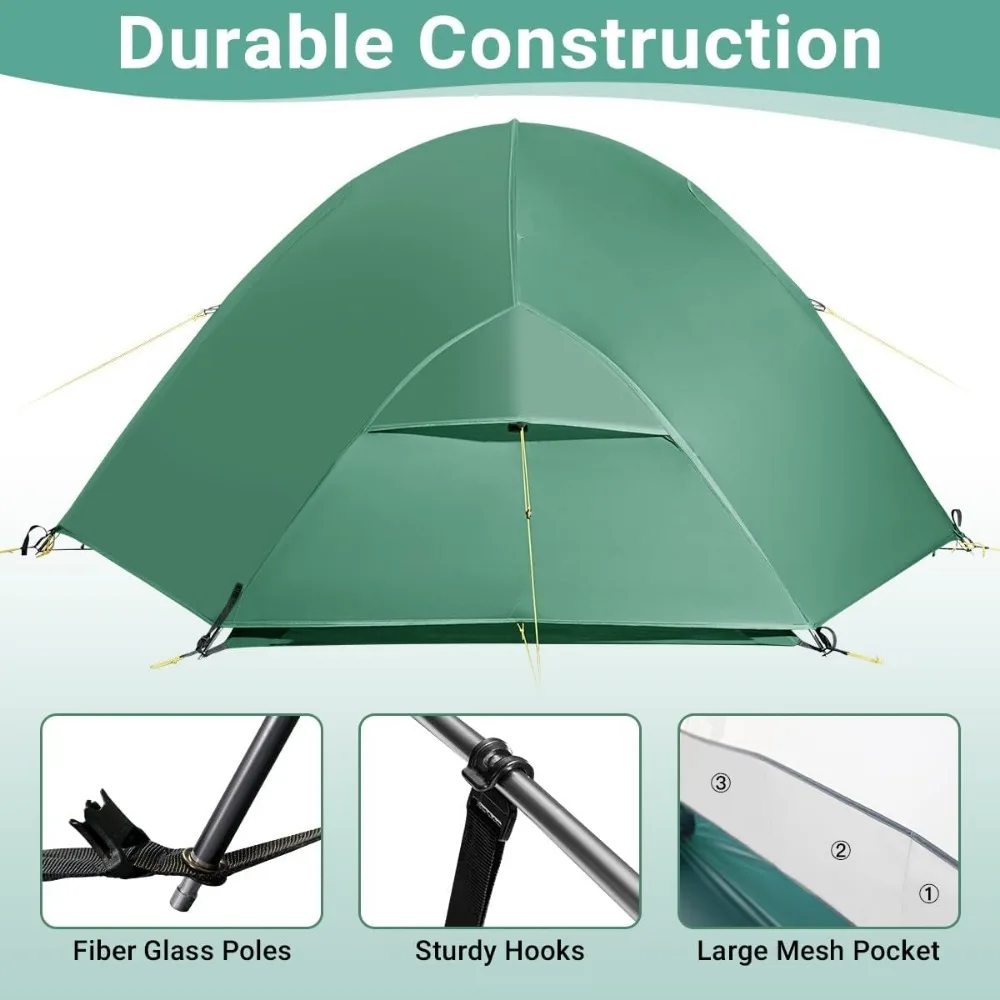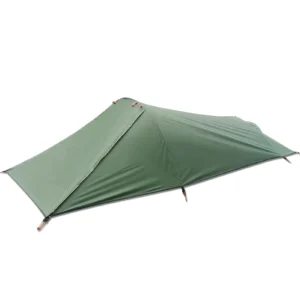Choosing the right tent for your hiking adventures involves balancing several factors, with weight being one of the most critical. A tent that’s too heavy can drain your energy and diminish your hiking experience, while one that’s too light might sacrifice comfort or durability. This guide will help you understand tent weight considerations and find your perfect balance.
Understanding Tent Weight Fundamentals
The weight of your tent directly impacts your hiking experience. A heavy tent increases fatigue, slows your pace, and can reduce the distance you’re able to cover comfortably. When you’re carrying everything on your back for miles, even a few extra ounces can make a significant difference by the end of the day.
Manufacturers typically list several different weight specifications, which can be confusing when comparing options:
- Packed Weight (Total Weight): Everything that comes in the package, including the tent body, rainfly, poles, stakes, guy lines, stuff sacks, and instructions
- Trail Weight (Minimum Trail Weight): Just the essential components needed for setup—typically the tent body, rainfly, and poles
- Fast Pitch/Fast Fly Weight: The minimalist setup weight, often just the rainfly, poles, and footprint
For practical comparison, most hikers rely on trail weight, which is typically 15-20% lighter than the packed weight. However, your actual carried weight may fall somewhere between these numbers, depending on how many components you bring.
Understanding these specifications helps you make accurate comparisons between lightweight tents for long treks and evaluate what makes a lightweight tent suitable for your needs.
Hiking Tent Weight Guidelines by Category
A helpful starting point when considering tent weight is the “per person” rule of thumb: aim for about 2.2-2.75 pounds (1-1.25kg) per person. This provides a quick benchmark, but let’s break it down more specifically by category:
| Weight Category | 2-Person Tent | Features | Best For |
|---|---|---|---|
| Ultralight | Under 3 lbs (1.4 kg) | Minimal features, specialized materials | Thru-hikers, long-distance trekkers |
| Lightweight | 3-4.5 lbs (1.4-2 kg) | Good balance of features and weight | Weekend backpackers, weight-conscious hikers |
| Standard/Midweight | 4.5-6 lbs (2-2.7 kg) | More durable, spacious, feature-rich | Occasional backpackers, varied conditions |
| Heavy/Budget | Over 6 lbs (2.7+ kg) | Maximum durability and features | Car camping, short hikes, budget priorities |
Remember that these categories scale approximately with capacity—a 1-person ultralight tent would typically weigh less than 2.5 pounds (1.1 kg), while a 3-person lightweight tent might weigh 5-6 pounds (2.3-2.7 kg).
Experienced hikers develop strong opinions about how much a backpacking tent should weigh based on their personal experiences. If minimizing weight is your top priority, consider exploring specialized ultralight backpacking tent options.
Tent Capacity and Weight Correlation
Tent capacity significantly affects overall weight, but not in a strictly linear fashion. Here’s how weight typically scales with capacity:
- 1-Person Tents: 1-3 pounds (0.45-1.4 kg)
- 2-Person Tents: 2-5 pounds (0.9-2.3 kg)
- 3-Person Tents: 3-7 pounds (1.4-3.2 kg)
- 4+ Person Tents: 5-10+ pounds (2.3-4.5+ kg)
Interestingly, the weight-per-person becomes more efficient as capacity increases. A 3-person tent rarely weighs 50% more than a comparable 2-person tent from the same line, making larger tents potentially more efficient when weight can be distributed among hikers.
Many solo hikers opt to “size up” to a 2-person tent for additional comfort, which adds minimal weight but significantly increases living space. For couples or hiking partners, 2-person backpacking tents offer the optimal balance of weight efficiency and comfort when the load is shared.
Seasonality and Weather Protection: Impact on Weight
The intended season and weather conditions for your tent significantly impact its weight. The primary distinction is between 3-season and 4-season tents:
- 3-Season Tents: Designed for spring, summer, and fall use in mild to moderate conditions
- 4-Season Tents: Built for winter use and harsh weather, including snow loads and high winds
A 4-season tent typically weighs 25-40% more than a comparable 3-season model due to several structural differences:
* Stronger, more numerous poles to withstand snow loads
* Thicker, more robust fabrics for durability in harsh conditions
* Less mesh and more solid fabric for heat retention
* Reinforced tie-down points and stake loops
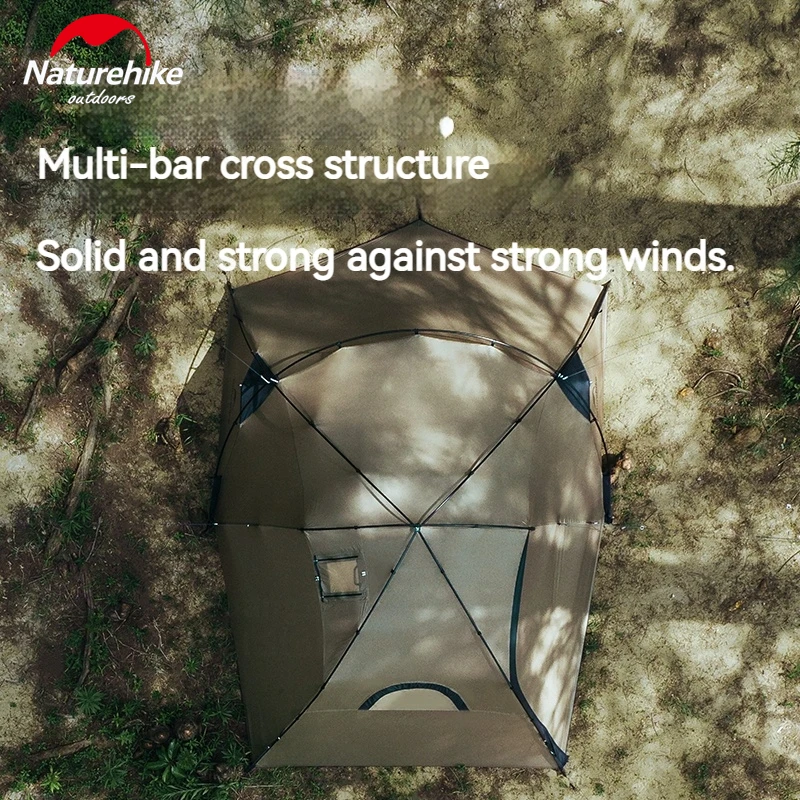
While a 3-season tent might suffice for most hikers, those venturing into winter conditions or high-altitude environments should consider 4-season winter 2-person tents despite the weight penalty. The extra weight translates to four-season tents built for durability that can withstand extreme conditions—a worthwhile trade-off when safety is at stake.
Tent Materials: The Weight Game-Changers
The materials used in tent construction play a crucial role in determining overall weight:
Fabrics:
* Nylon variants: Silnylon (silicone-coated nylon) offers good strength-to-weight ratio and water resistance but can stretch when wet
* Polyester options: Silpoly (silicone-coated polyester) doesn’t absorb water or stretch as much as nylon but may be less tear-resistant
* Premium ultralight materials: Dyneema Composite Fabric (formerly Cuben Fiber) delivers exceptional strength at minimal weight but at a premium price
Fabric thickness is measured in denier (D)—the lower the number, the lighter but typically less durable the material. Ultralight tents might use 10-15D fabrics, while more durable options use 30-70D materials.
Poles:
* Aluminum alloys: Standard DAC aluminum poles balance weight and strength
* Carbon fiber: Reduces pole weight by up to 30% compared to aluminum but costs more and may be less durable
* Other alternatives: Trekking pole setups eliminate dedicated pole weight entirely
Understanding lightweight trekking shelter materials helps you make informed decisions about durability versus weight savings when selecting your tent.
Tent Design Features That Affect Weight
Beyond materials, design choices significantly impact tent weight:
Wall Configuration:
* Single-wall designs: Combine the rainfly and tent body into one layer, saving weight but potentially increasing condensation
* Double-wall designs: Separate tent body and rainfly provide better ventilation and versatility at a weight cost
Support Structure:
* Freestanding tents: Can stand without stakes, offering setup flexibility but requiring more pole material
* Non-freestanding/semi-freestanding: Require stakes or trekking poles for setup but can be significantly lighter
Other Weight-Adding Features:
* Additional doors (100-200g/3.5-7oz per extra door and vestibule)
* Larger vestibules for gear storage
* Interior storage pockets and gear lofts
* Ventilation systems and features
* Reinforced stress points
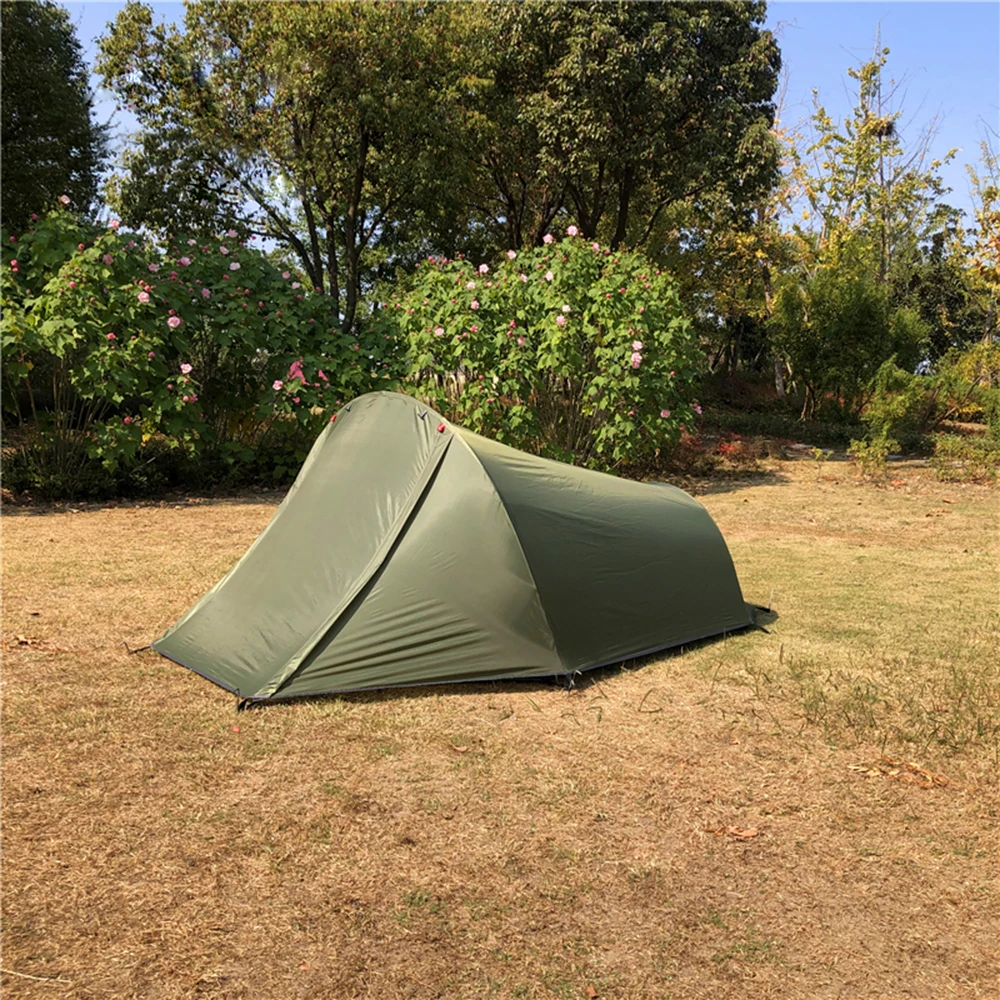
For the most weight-conscious hikers, trekking pole backpacking tents offer substantial weight savings by eliminating dedicated tent poles. Understanding how trekking pole tents work can help you determine if this ultralight approach matches your hiking style.
Essential Weight Trade-Offs: What You Gain and Lose
When considering tent weight, it’s important to understand what you’re gaining or sacrificing with each weight reduction:
Weight vs. Durability
Lighter tents typically use thinner materials that may tear more easily. A tent that saves 1.1 pounds (500g) by using 10D instead of 30D fabric may have three times less puncture resistance.
Weight vs. Living Space
Ultralight designs often reduce internal volume, headroom, and floor dimensions. A tent that saves 14 ounces (400g) might reduce interior space by 20-30%.
Weight vs. Weather Protection
Lighter designs may perform adequately in good conditions but offer less protection in sustained bad weather. They typically have fewer guy-out points and less robust waterproofing.
Weight vs. Setup Simplicity
Non-freestanding designs save weight but require more skill and suitable ground for staking. They can be challenging to set up on rocky surfaces or in bad weather.
Weight vs. Cost
Premium lightweight materials significantly increase price. Saving 1 pound (0.45kg) with high-end materials might add $100-200 to the cost.
Understanding the 20 percent rule in backpacking can help you decide which trade-offs align with your priorities.
Matching Tent Weight to Your Hiking Style
Your ideal tent weight depends greatly on your hiking approach:
Ultralight Backpacking/Thru-Hiking
* Target weight: Under 2.5 pounds (1.1 kg) for one person
* Prioritizes minimal weight for covering long daily distances
* Often accepts significant trade-offs in durability and features
Weekend Backpacking
* Target weight: 2.5-4 pounds (1.1-1.8 kg) for one person
* Balances weight with comfort for shorter trips
* Moderate durability needs for varied conditions
Base Camping
* Target weight: 3-5+ pounds (1.4-2.3+ kg) for one person
* Emphasizes comfort and durability over weight
* Typically involves shorter hiking distances to established camps
Mountaineering/Winter Camping
* Target weight: 4-7+ pounds (1.8-3.2+ kg) for one person
* Requires robust construction for extreme conditions
* Weight secondary to safety and protection
Personal factors also influence your ideal tent weight, including physical fitness, comfort preferences, and budget constraints. Hikers interested in minimizing weight should explore specialized ultralight tent features for thru-hiking.
Tent Weight in Your Total Pack System
Your tent should be considered as part of your overall pack weight, particularly in relation to the “Big Three”—your tent, backpack, and sleeping system (bag/pad). These three items typically constitute about 60% of your total base weight.
As a general guideline:
* Ultralight approach: Tent = 10-15% of base weight
* Lightweight approach: Tent = 15-20% of base weight
* Traditional approach: Tent = 20-25% of base weight
For example, if you’re targeting a 20-pound (9 kg) base weight with a lightweight approach, your tent should weigh around 3-4 pounds (1.4-1.8 kg).
When considering if 3kg is too heavy for a backpacking tent, remember that the answer depends on your overall pack system and personal preferences.
Smart Strategies for Managing Tent Weight
Share the load when hiking with partners
Distribute tent components—one person carries poles and stakes, another carries the tent body and rainfly.Consider seasonal adjustments
Use a lighter tent for summer trips and a more robust one for shoulder seasons or winter.Evaluate footprint necessity
Skip the footprint in good conditions or use lightweight alternatives like Tyvek or polycro.Pack minimally
Leave behind unnecessary stakes, repair kits, or stuff sacks for shorter trips in good weather.Test your setup
Before a long trip, take your tent on a shorter hike to evaluate if the weight feels appropriate.
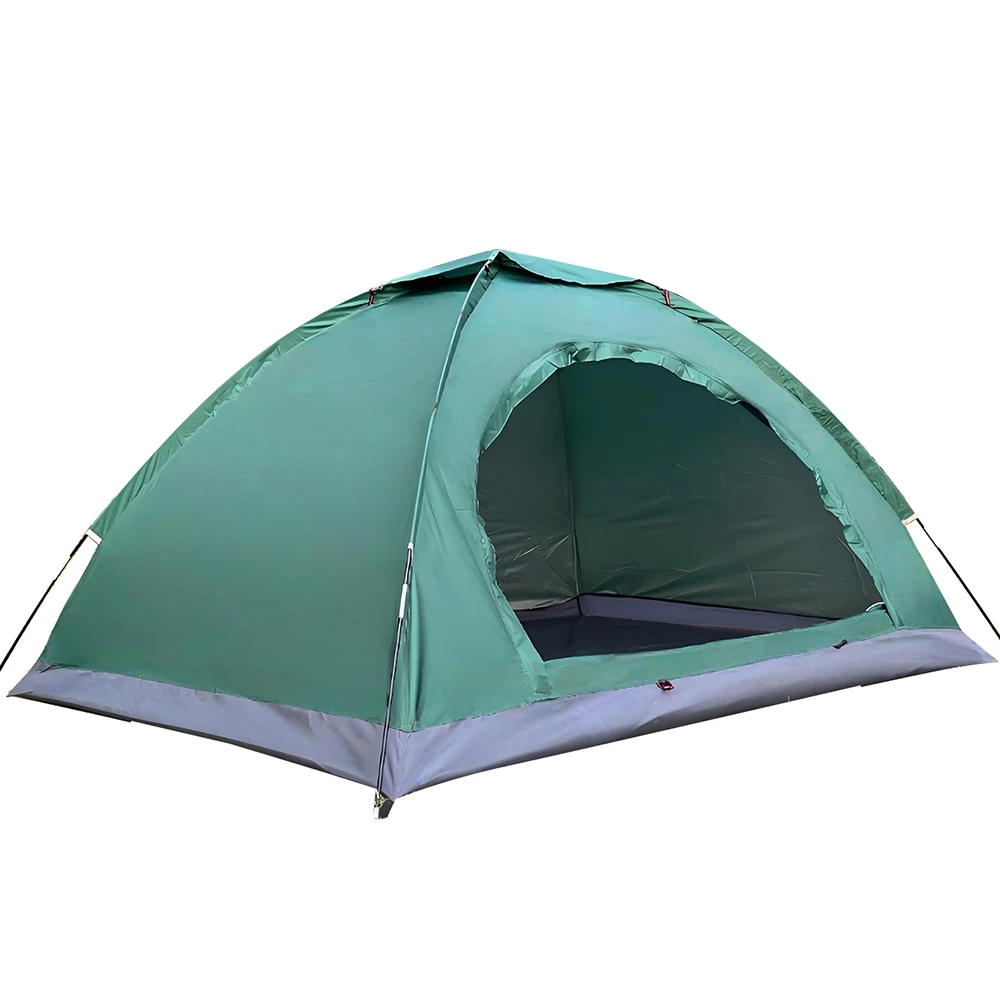
Lightweight Backpacking Tent, Ultralight Backpacking Tent, Ultralight Bivy Tent
Ultralight Single Person Camping Tent with Aluminum Poles for 3-Season Backpacking Waterproof DesignPrice range: $94.88 through $326.82 Select options This product has multiple variants. The options may be chosen on the product pageLightweight Backpacking Tent, Ultralight Backpacking Tent, Waterproof Backpacking Tent
$391.05 Select options This product has multiple variants. The options may be chosen on the product pageHeavy Duty 4 Season Tent, Mountaineering Tent, Winter Camping Tent
$870.40 Select options This product has multiple variants. The options may be chosen on the product pageCompact Backpacking Tent, Lightweight Backpacking Tent, Waterproof Camping Tent
$335.52 Select options This product has multiple variants. The options may be chosen on the product pageUltralight Backpacking Tent, Ultralight Dome Tent, Winter Camping Tent
Price range: $369.63 through $370.07 Select options This product has multiple variants. The options may be chosen on the product pageHeavy Duty 4 Season Tent, Ultralight Freestanding Tent, Winter Camping Tent
$3,722.66 Select options This product has multiple variants. The options may be chosen on the product page
For most hikers, lightweight backpacking tents offer the best balance of weight savings and practical features without the extreme compromises of ultralight options.
Common Questions About Hiking Tent Weight
Is it worth paying more for a lighter tent?
Yes, if you hike frequently or for long distances. The cumulative fatigue reduction from carrying less weight can significantly enhance your hiking experience, especially on multi-day trips.
How much weight difference actually matters?
Even 8-16 ounces (250-500g) makes a noticeable difference over long distances. Think of it as removing a full water bottle from your pack.
Can I use an ultralight tent in harsh weather?
Some premium ultralight tents perform well in bad weather, but generally, as weight decreases, weather resistance becomes more compromised. Always match your tent to expected conditions.
Should I prioritize tent weight over other gear weight?
Focus on reducing the weight of your “Big Three” items (tent, backpack, sleeping system) first, as they make up the largest portion of your load.
How does tent weight affect hiking distance capabilities?
A lighter tent can increase comfortable daily distance by reducing fatigue. Some hikers report being able to hike 2-5 additional miles per day after significantly reducing pack weight.
For deeper insights into finding the right balance of features and weight, explore our guide to essential features in trekking tents.
Expert Tips for Long-Term Tent Weight Management
Experienced hikers often develop nuanced approaches to tent weight over time:
- Progressive weight reduction – Start with a moderate weight tent and upgrade as you gain experience and refine your needs
- Maintenance matters – Regular cleaning prevents dirt and moisture accumulation that adds weight over time
- Seasonal swapping – Many experienced hikers own multiple tents optimized for different conditions
- Component flexibility – Adapt what you carry based on conditions (e.g., fewer stakes in good weather)
- Personal threshold awareness – Understand your own comfort-to-weight ratio through experience
Most hikers find that their preferences evolve toward lighter gear over time as they gain confidence in their skills and learn which comforts they can forgo. However, the perfect tent strikes a personal balance between weight, protection, and comfort.
For those ready to take their lightweight hiking to the next level, our guide to ultralight trekking tents for long-distance hikers provides advanced strategies and recommendations from Explore Elements.
Remember, the ideal tent weight isn’t about reaching an arbitrary number—it’s about finding the sweet spot that enhances your personal hiking experience through the right balance of comfort, protection, and portable weight.

